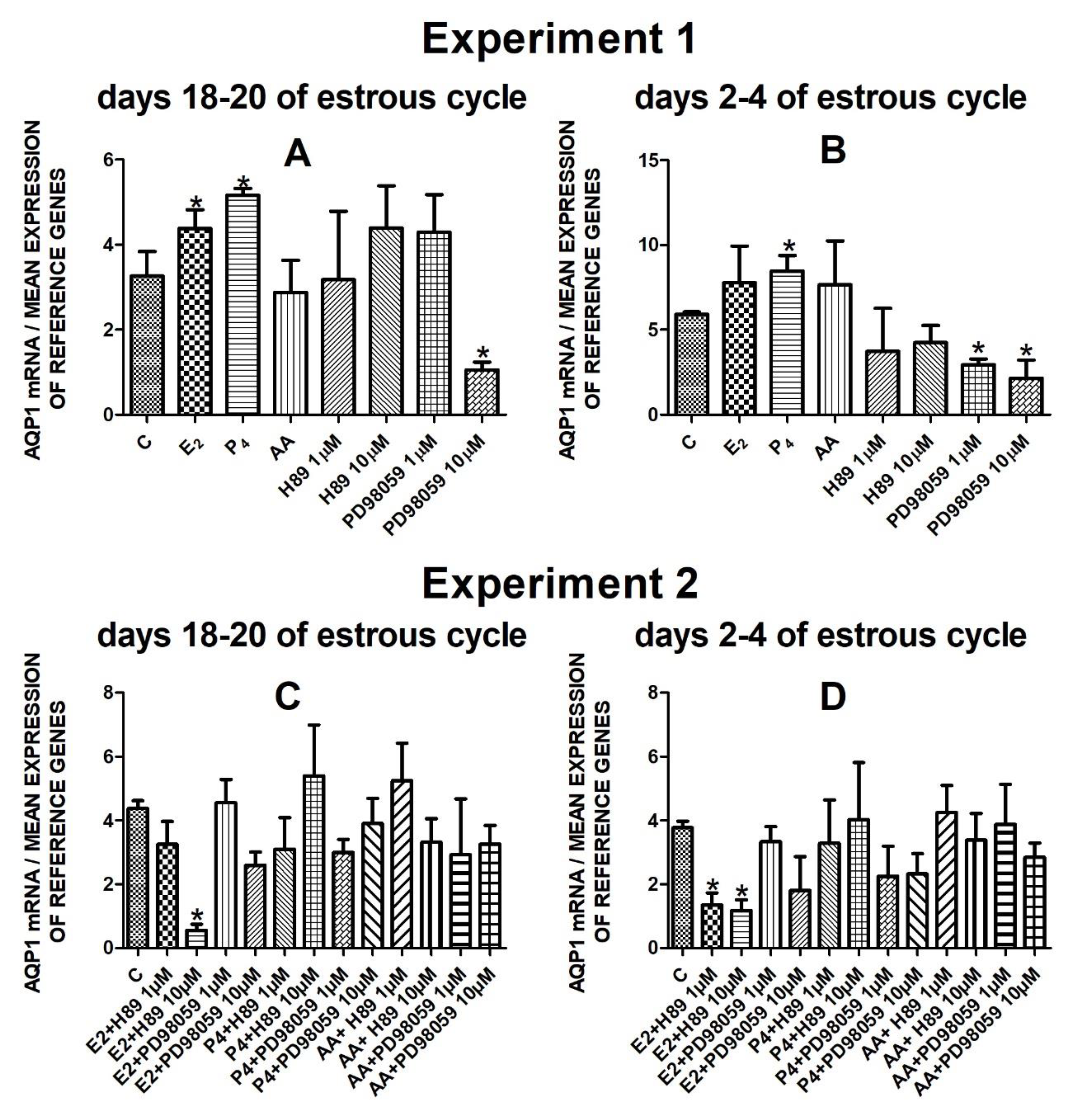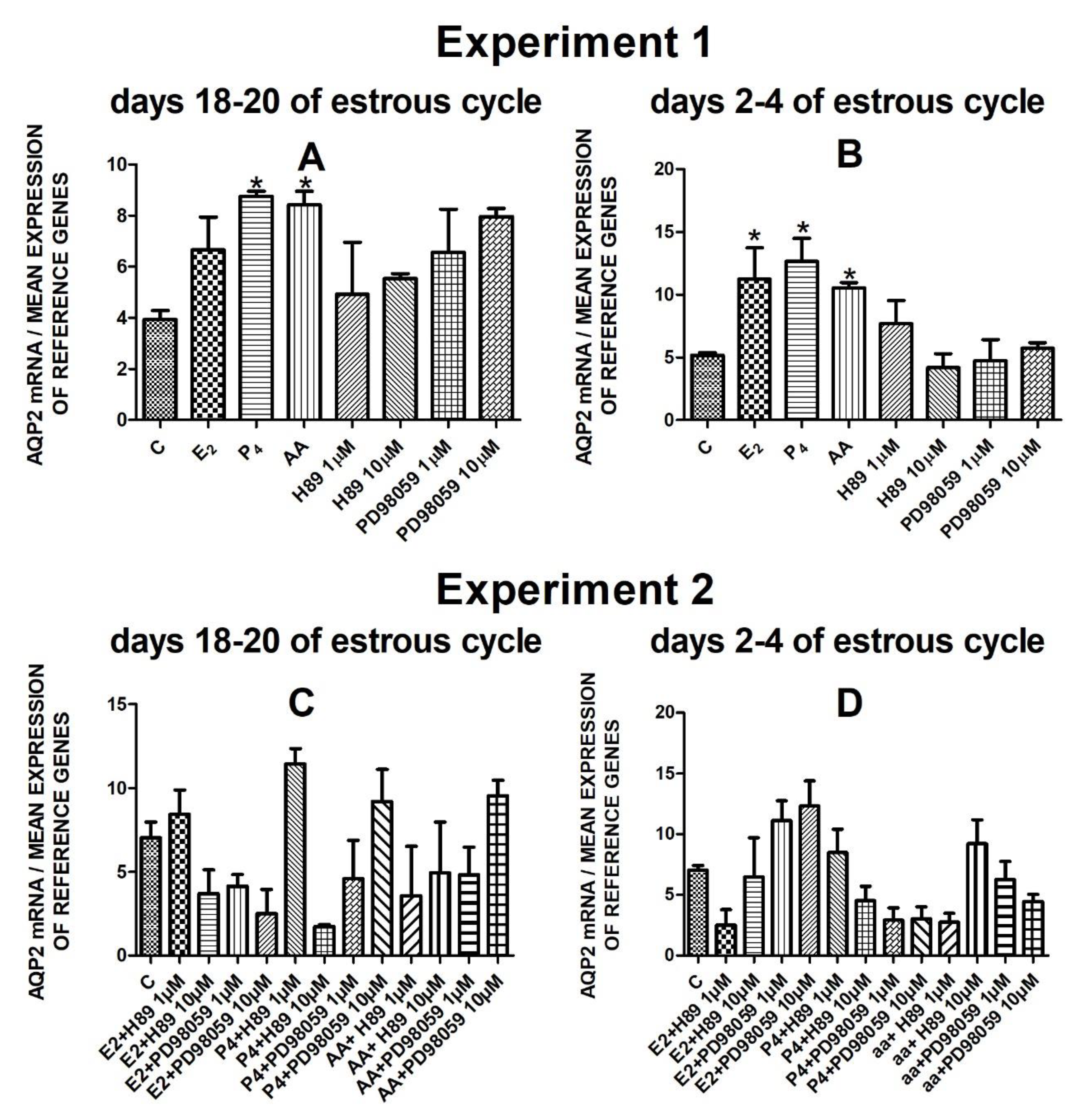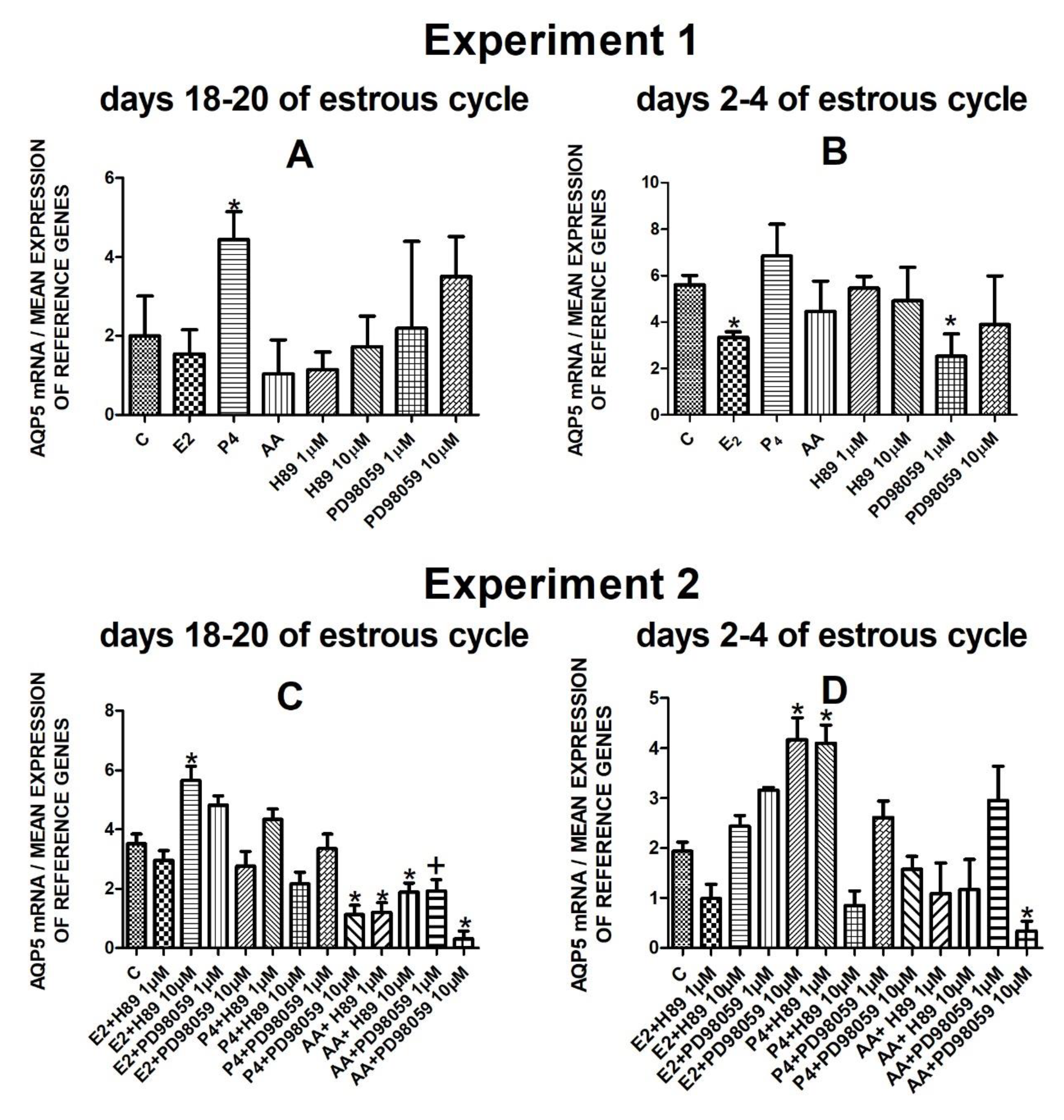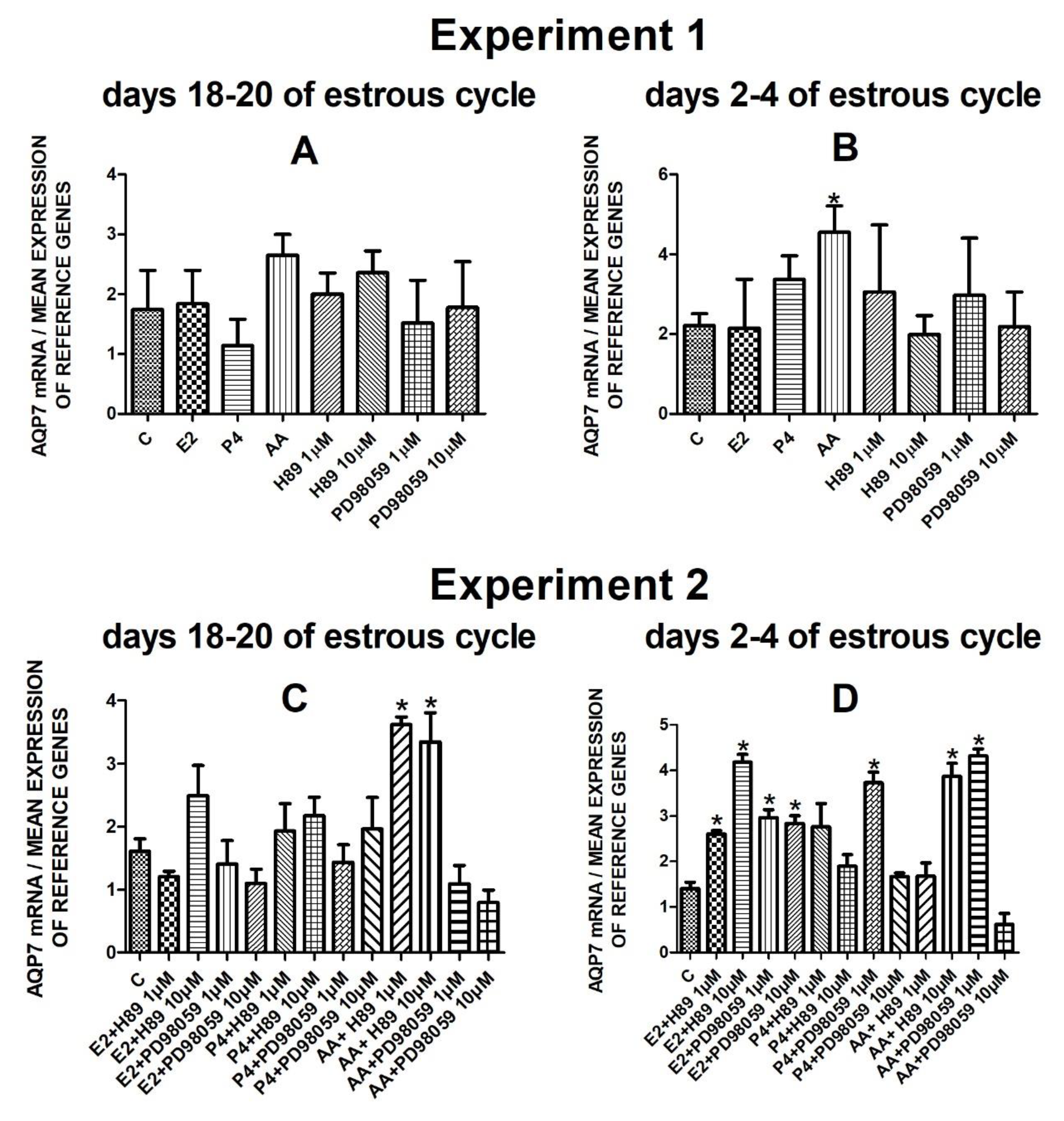The In Vitro Effect of Steroid Hormones, Arachidonic Acid, and Kinases Inhibitors on Aquaporin 1, 2, 5, and 7 Gene Expression in the Porcine Uterine Luminal Epithelial Cells during the Estrous Cycle
Abstract
:1. Introduction
2. Materials and Methods
2.1. Experimental Animals and Tissue Collection
2.2. Isolation of Uterine Luminal Epithelial Cells
2.3. Cell Culture
- Experiment 1:
- Experiment 2:
2.4. RNA Isolation
2.5. cDNA Synthesis and Quantitative Real-Time Polymerase Chain Reaction Analysis
2.6. Statistical Analysis
3. Results
3.1. The Effect of Estradiol, Progesterone, Arachidonic Acid, and Kinases Inhibitors (H89—PKA Inhibitor, PD98059—MAPK Inhibitor) on Aquaporin 1, 2, 5, and 7 mRNA Expressions in the Porcine Endometrial Luminal Epithelial Cells (Experiment 1)
3.2. The Effect of Estradiol, Progesterone, and Arachidonic Acid Combined with Kinases Inhibitors (H89—PKA Inhibitor, PD98059—MAPK Inhibitor) on Aquaporin 1, 2, 5, and 7 mRNA Expressions in the Porcine Endometrial Luminal Epithelial Cells (Experiment 2)
4. Discussion
5. Conclusions
Author Contributions
Funding
Institutional Review Board Statement
Data Availability Statement
Conflicts of Interest
References
- Spencer, T.E.; Johnson, G.A.; Burghardt, R.C.; Bazer, F.W. Progesterone and Placental Hormone Actions on the Uterus: Insights from Domestic Animals. Biol. Reprod. 2004, 71, 2–10. [Google Scholar] [CrossRef] [Green Version]
- Ducza, E.; Csányi, A.; Gáspár, R. Aquaporins during Pregnancy: Their Function and Significance. Int. J. Mol. Sci. 2017, 18, 2593. [Google Scholar] [CrossRef] [Green Version]
- Kordowitzki, P.; Kranc, W.; Bryl, R.; Kempisty, B.; Skowronska, A.; Skowronski, M.T. The Relevance of Aquaporins for the Physiology, Pathology, and Aging of the Female Reproductive System in Mammals. Cells 2020, 9, 2570. [Google Scholar] [CrossRef] [PubMed]
- Zhang, D.; Tan, Y.-J.; Qu, F.; Sheng, J.-Z.; Huang, H.-F. Functions of water channels in male and female reproductive systems. Mol. Asp. Med. 2012, 33, 676–690. [Google Scholar] [CrossRef]
- Li, X.; Yu, H.; Koide, S.S. The water channel gene in human uterus. Biochem. Mol. Boil. Int. 1994, 32, 371–377. [Google Scholar]
- Huang, H.-F.; He, R.-H.; Sun, C.-C.; Zhang, Y.; Meng, Q.-X.; Ma, Y.-Y. Function of aquaporins in female and male reproductive systems. Hum. Reprod. Update 2006, 12, 785–795. [Google Scholar] [CrossRef] [PubMed] [Green Version]
- Zhu, C.; Jiang, Z.; Bazer, F.W.; Johnson, G.A.; Burghardt, R.C.; Wu, G. Aquaporins in the female reproductive system of mammals. Front. Biosci. 2015, 20, 838–871. [Google Scholar] [CrossRef] [Green Version]
- Khan, S.; Ricciardelli, C.; Yool, A. Targeting Aquaporins in Novel Therapies for Male and Female Breast and Reproductive Cancers. Cells 2021, 10, 215. [Google Scholar] [CrossRef]
- Jablonski, E.M.; McConnell, N.A.; Hughes, F.M., Jr.; Huet-Hudson, Y.M. Estrogen Regulation of Aquaporins in the Mouse Uterus: Potential Roles in Uterine Water Movement. Biol. Reprod. 2003, 69, 1481–1487. [Google Scholar] [CrossRef]
- Zhu, X. Expression of AQP3 protein in hAECs is regulated by Camp-PKA-CREB signalling pathway. Front. Biosci. 2015, 20, 1047–1055. [Google Scholar] [CrossRef] [PubMed] [Green Version]
- Skowrońska, A.; Młotkowska, P.; Wojciechowicz, B.; Okrasa, S.; Nielsen, S.; Skowronski, M.T. Progesterone, estradiol, arachidonic acid, oxytocin, forskolin and cAMP influence on aquaporin 1 and 5 expression in porcine uterine explants during the mid-luteal phase of the estrous cycle and luteolysis: An in vitro study. Reprod. Biol. Endocrinol. 2015, 13, 7. [Google Scholar] [CrossRef] [PubMed] [Green Version]
- Kitchen, P.; Day, R.E.; Taylor, L.H.J.; Salman, M.M.; Bill, R.M.; Conner, M.T.; Conner, A.C. Identification and Molecular Mechanisms of the Rapid Tonicity-induced Relocalization of the Aquaporin 4 Channel. J. Biol. Chem. 2015, 290, 16873–16881. [Google Scholar] [CrossRef] [Green Version]
- Roche, J.V.; Survery, S.; Kreida, S.; Nesverova, V.; Ampah-Korsah, H.; Gourdon, M.; Deen, P.M.T.; Törnroth-Horsefield, S. Phosphorylation of human aquaporin 2 (AQP2) allosterically controls its interaction with the lysosomal trafficking protein LIP. J. Biol. Chem. 2017, 292, 14636–14648. [Google Scholar] [CrossRef] [Green Version]
- Yang, F.; Kawedia, J.D.; Menon, A.G. Cyclic AMP Regulates Aquaporin 5 Expression at Both Transcriptional and Post-transcriptional Levels through a Protein Kinase A Pathway. J. Biol. Chem. 2003, 278, 32173–32180. [Google Scholar] [CrossRef] [Green Version]
- Woo, J.; Chae, Y.K.; Jang, S.J.; Kim, M.S.; Baek, J.H.; Park, J.C.; Trink, B.; Ratovitski, E.; Lee, T.; Park, B.; et al. Membrane trafficking of AQP5 and cAMP dependent phosphorylation in bronchial epithelium. Biochem. Biophys. Res. Commun. 2008, 366, 321–327. [Google Scholar] [CrossRef]
- Nesverova, V.; Törnroth-Horsefield, S. Phosphorylation-Dependent Regulation of Mammalian Aquaporins. Cells 2019, 8, 82. [Google Scholar] [CrossRef] [PubMed] [Green Version]
- Moon, S.; Lee, O.-H.; Lee, S.; Lee, J.; Park, H.; Park, M.; Chang, E.M.; Park, K.H.; Choi, Y. STK3/4 Expression Is Regulated in Uterine Endometrial Cells during the Estrous Cycle. Cells 2019, 8, 1643. [Google Scholar] [CrossRef] [PubMed] [Green Version]
- Weiner, J.; Sun, W.L.; Zhou, L.; Kreiter, C.; Jenab, S.; Quiñones-Jenab, V. PKA-mediated responses in females’ estrous cycle affect cocaine-induced responses in dopamine-mediated intracellular cascades. Neuroscience 2009, 161, 865–876. [Google Scholar] [CrossRef]
- Kim, S.T.; Moley, K.H. Regulation of Facilitative Glucose Transporters and AKT/MAPK/PRKAA Signaling via Estradiol and Progesterone in the Mouse Uterine Epithelium. Biol. Reprod. 2009, 81, 188–198. [Google Scholar] [CrossRef] [Green Version]
- Søberg, K.; Moen, L.V.; Skålhegg, B.S.; Laerdahl, J.K. Evolution of the cAMP-dependent protein kinase (PKA) catalytic subunit isoforms. PLoS ONE 2017, 12, e0181091. [Google Scholar] [CrossRef] [Green Version]
- Taylor, S.S.; Zhang, P.; Steichen, J.M.; Keshwani, M.M.; Kornev, A.P. PKA: Lessons learned after twenty years. Biochim. Biophys. Acta BBA Proteins Proteom. 2013, 1834, 1271–1278. [Google Scholar] [CrossRef] [Green Version]
- Engh, R.A.; Girod, A.; Kinzel, V.; Huber, R.; Bossemeyer, D. Crystal structures of catalytic subunit of cAMP-dependent protein kinase in complex with isoquinolinesulfonyl protein kinase inhibitors H7, H8, and HStructural implications for selectivity. J. Biol. Chem. 1996, 271. [Google Scholar] [CrossRef] [Green Version]
- Wang, K.; Hou, Y.; Gu, C.; Zhao, D.; Duan, Y.; Ran, Z.; Li, Q.; Li, X. Inhibitory effect of the mitogen activated protein kinase specific inhibitor PD98059 on Mtb-Ag-activated γδΤ cells. Int. J. Clin. Exp. Pathol. 2017, 10, 9644–9648. [Google Scholar] [PubMed]
- Ouyang, L.; Chen, Y.; Wang, X.Y.; Lu, R.F.; Zhang, S.Y.; Tian, M.; Xie, T.; Liu, B.; He, G. Polygonatum odoratum lectin induces apoptosis and autophagy via targeting EGFR-mediated Ras-Raf-MEK-ERK pathway in human MCF-7 breast cancer cells. Phytomedicine 2014, 21, 1658–1665. [Google Scholar] [CrossRef] [PubMed]
- Skowronska, A.; Mlotkowska, P.; Okrasa, S.; Nielsen, S.; Skowronski, M.T. Modulatory effects of steroid hormones, oxytocin, arachidonic acid, forskolin and cyclic AMP on the expression of aquaporin 1 and aquaporin 5 in the porcine uterus during placentation. J. Physiol. Pharmacol. 2016, 67, 311–319. [Google Scholar]
- Skowronska, A.; Mlotkowska, P.; Majewski, M.; Nielsen, S.; Skowronski, M.T. Expression of aquaporin 1 and 5 and their regulation by ovarian hormones, arachidonic acid, forskolin and cAMP during implantation in pigs. Physiol. Res. 2016, 65, 637–650. [Google Scholar] [CrossRef]
- Skowronska, A.; Mlotkowska, P.; Nielsen, S.R.K.; Skowronski, M.T. Difference in expression between AQP1 and AQP5 in porcine endometrium and myometrium in response to steroid hormones, oxytocin, arachidonic acid, forskolin and cAMP during the mid-luteal phase of the estrous cycle and luteolysis. Reprod. Biol. Endocrinol. 2015, 13, 1–11. [Google Scholar] [CrossRef] [PubMed] [Green Version]
- Skowronski, M.T.; Kwon, T.-H.; Nielsen, S. Immunolocalization of Aquaporin 1, 5, and 9 in the Female Pig Reproductive System. J. Histochem. Cytochem. 2008, 57, 61–67. [Google Scholar] [CrossRef] [PubMed] [Green Version]
- Skowronski, M.T. Distribution and quantitative changes in amounts of aquaporin 1, 5 and 9 in the pig uterus during the estrous cycle and early pregnancy. Reprod. Biol. Endocrinol. 2010, 8, 109. [Google Scholar] [CrossRef] [Green Version]
- Wojtanowicz-Markiewicz, K.; Kulus, M.; Knap, S.; Kocherova, I.; Jankowski, M.; Stefańska, K.; Jeseta, M.; Piotrowska-Kempisty, H.; Bukowska, D.; Zabel, M.; et al. Expression of Selected Connexin and Aquaporin Genes and Real-Time Proliferation of Porcine Endometrial Luminal Epithelial Cells in Primary Culture Model. BioMed Res. Int. 2020, 1–15. [Google Scholar] [CrossRef]
- Ferré-Dolcet, L.; Yeste, M.; Vendrell, M.; Rigau, T.; Rodríguez-Gil, J.E.; Del Alamo, M.M.R. Uterine and placental specific localization of AQP2 and AQP8 is related with changes of serum progesterone levels in pregnant queens. Theriogenology 2020, 142, 149–157. [Google Scholar] [CrossRef] [PubMed]
- Richard, C.; Gao, J.; Brown, N.; Reese, J. Aquaporin Water Channel Genes Are Differentially Expressed and Regulated by Ovarian Steroids during the Periimplantation Period in the Mouse. Endocrinology 2003, 144, 1533–1541. [Google Scholar] [CrossRef] [PubMed] [Green Version]
- Lindsay, L.A.; Murphy, C.R. Aquaporins are upregulated in glandular epithelium at the time of implantation in the rat. J. Mol. Histol. 2007, 38, 87–95. [Google Scholar] [CrossRef] [PubMed]
- He, R.-H.; Sheng, J.-Z.; Luo, Q.; Jin, F.; Wang, B.; Qian, Y.-L.; Zhou, C.-Y.; Sheng, X.; Huang, H.-F. Aquaporin-2 expression in human endometrium correlates with serum ovarian steroid hormones. Life Sci. 2006, 79, 423–429. [Google Scholar] [CrossRef]
- Cui, D.; Sui, L.; Zhu, C.; Ma, Y.; Zhang, M.; Guo, Z.; Xie, Y.; Kong, Y. Expression of AQP 3 in the mice endometrium during estrous cycle and early pregnancy. Int. J. Clin. Exp. Pathol. 2016, 9, 8037–8046. [Google Scholar]
- Peng, H.; Zhang, Y.; Lei, L.; Chen, Q.; Yue, J.; Tan, Y.; Duan, E. Aquaporin 7 expression in postimplantation mouse uteri: A potential role for glycerol transport in uterine decidualization. Fertil. Steril. 2011, 95, 1514.e3–1517.e3. [Google Scholar] [CrossRef] [PubMed]
- Akins, E.L.; Morrissette, M.C. Gross ovarian changes during estrous cycle of swine. Am. J. Veter. Res. 1968, 29, 1953–1957. [Google Scholar]
- Valenti, G.; Procino, G.; Carmosino, M.; Frigeri, A.; Mannucci, R.; Nicoletti, I.; Svelto, M. The phosphatase inhibitor okadaic acid induces AQP2 translocation independently from AQP2 phosphorylation in renal collecting duct cells. J. Cell Sci. 2000, 113, 1985–1992. [Google Scholar]
- Yuan, W.; Bers, D.M. Protein kinase inhibitor H-89 reverses forskolin stimulation of cardiac L-type calcium current. Am. J. Physiol. Physiol. 1995, 268, C651–C659. [Google Scholar] [CrossRef]
- Chinigarzadeh, A.; Muniandy, S.; Salleh, N. Estradiol, progesterone and genistein differentially regulate levels of aquaporin (AQP)-1, 2, 5 and 7 expression in the uteri of ovariectomized, sex-steroid deficient rats. Steroids 2016, 115, 47–55. [Google Scholar] [CrossRef]
- He, R.; Han, W.; Hu, Y.; Chen, X.; Hu, X.; Zhu, Y. AQP2 is regulated by estradiol in human endometrium and is associated with spheroid attachment in vitro. Mol. Med. Rep. 2019, 20, 1306–1312. [Google Scholar] [CrossRef]
- Salleh, N.; Mokhtar, H.M.; Kassim, N.M.; Giribabu, N. Testosterone Induces Increase in Aquaporin (AQP)-1, 5, and 7 Expressions in the Uteri of Ovariectomized Rats. J. Membr. Biol. 2015, 248, 1097–1105. [Google Scholar] [CrossRef] [PubMed]
- Kim, J.M.; Park, J.E.; Yoo, I.; Han, J.; Kim, N.; Lim, W.J.; Cho, E.S.; Choi, B.; Choi, S.; Kim, T.H.; et al. Integrated transcriptomes throughout swine oestrous cycle reveal dynamic changes in reproductive tissues interacting networks. Sci. Rep. 2018, 8, 5436. [Google Scholar] [CrossRef] [PubMed]
- Zannetti, A.; Benga, G.; Brunetti, A.; Napolitano, F.; Avallone, L.; Pelagalli, A. Role of Aquaporins in the Physiological Functions of Mesenchymal Stem Cells. Cells 2020, 9, 2678. [Google Scholar] [CrossRef]
- Norman, S.; Poyser, N. Effects of inhibitors of arachidonic acid turnover on the production of prostaglandins by the guinea-pig uterus. J. Reprod. Fertil. 2000, 118, 181–186. [Google Scholar] [CrossRef] [PubMed]
- Hertelendy, F.; Zakár, T. Prostaglandins and the myometrium and cervix. Prostaglandins, Leukot. Essent. Fat. Acids 2004, 70, 207–222. [Google Scholar] [CrossRef]
- Li, Y.; Wei, Y.; Zheng, F.; Guan, Y.; Zhang, X. Prostaglandin E2 in the Regulation of Water Transport in Renal Collecting Ducts. Int. J. Mol. Sci. 2017, 18, 2539. [Google Scholar] [CrossRef] [PubMed] [Green Version]
- Murer, L.; Addabbo, F.; Carmosino, M.; Procino, G.; Tamma, G.; Montini, G.; Rigamonti, W.; Zucchetta, P.; Della Vella, M.; Venturini, A.; et al. Selective Decrease in Urinary Aquaporin 2 and Increase in Prostaglandin E2 Excretion Is Associated with Postobstructive Polyuria in Human Congenital Hydronephrosis. J. Am. Soc. Nephrol. 2004, 15, 2705–2712. [Google Scholar] [CrossRef] [Green Version]
- Yarwood, S.J. Special Issue on “New Advances in Cyclic AMP Signalling”—An Editorial Overview. Cells 2020, 9, 2274. [Google Scholar] [CrossRef]
- Lochner, A.; Moolman, J.A. The many faces of H89: A review. Cardiovasc. Drug Rev. 2006, 24, 261–274. [Google Scholar] [CrossRef]
- Rosenberg, D.; Groussin, L.; Jullian, E.; Perlemoine, K.; Bertagna, X.; Bertherat, J. Role of the PKA-Regulated Transcription Factor CREB in Development and Tumorigenesis of Endocrine Tissues. Ann. N. Y. Acad. Sci. 2002, 968, 65–74. [Google Scholar] [CrossRef] [PubMed]
- Eyers, P.A.; Liu, J.; Hayashi, N.R.; Lewellyn, A.L.; Gautier, J.; Maller, J.L. Regulation of the G2/M Transition in Xenopus Oocytes by the cAMP-dependent Protein Kinase. J. Biol. Chem. 2005, 280, 24339–24346. [Google Scholar] [CrossRef] [PubMed] [Green Version]
- Han, S.J.; Conti, M. New Pathways from PKA to the Cdc2/cyclin B Complex in Oocytes: Wee1B as a Potential PKA Substrate. Cell Cycle 2005, 5, 227–231. [Google Scholar] [CrossRef] [PubMed] [Green Version]
- Burvall, K.; Palmberg, L.; Larsson, K. Expression of TNFalpha and its receptors R1 and R2 in human alveolar epithelial cells exposed to organic dust and the effects of 8-bromo-cAMP and protein kinase A modulation. Inflamm. Res. 2005, 54, 281–288. [Google Scholar] [CrossRef] [PubMed]
- Reuveni, H.; Livnah, N.; Geiger, T.; Klein, S.; Ohne, O.; Cohen, I.; Benhar, M.; Gellerman, G.; Levitzki, A. Toward a PKB Inhibitor: Modification of a Selective PKA Inhibitor by Rational Design. Biochemistry 2002, 41, 10304–10314. [Google Scholar] [CrossRef]
- Cosentino, C.; Di Domenico, M.; Porcellini, A.; Cuozzo, C.; De Gregorio, G.; Santillo, M.R.; Agnese, S.; Di Stasio, R.; Feliciello, A.; Migliaccio, A.; et al. p85 regulatory subunit of PI3K mediates cAMP–PKA and estrogens biological effects on growth and survival. Oncogene 2006, 26, 2095–2103. [Google Scholar] [CrossRef] [PubMed] [Green Version]
- Gomez-Concha, C.; Flores-Herrera, O.; Olvera-Sanchez, S.; Espinosa-Garcia, M.T.; Martinez, F. Progesterone synthesis by human placental mitochondria is sensitive to PKA inhibition by H. Int. J. Biochem. Cell Biol. 2011, 43, 1402–1411. [Google Scholar] [CrossRef]
- Yang, L.; Pan, Y.; Wu, Y.; Lin, S.; Dai, B.; Chen, H.; Wan, J. Excessive arachidonic acid induced actin bunching remodeling and podocyte injury via a PKA-c-Abl dependent pathway. Exp. Cell Res. 2020, 388, 111808. [Google Scholar] [CrossRef]
- Umenishi, F.; Schrier, R.W. Hypertonicity-induced Aquaporin-1 (AQP1) Expression Is Mediated by the Activation of MAPK Pathways and Hypertonicity-responsive Element in the AQP1 Gene. J. Biol. Chem. 2003, 278, 15765–15770. [Google Scholar] [CrossRef] [Green Version]
- Ren, Y.; Lu, H.; Reinach, P.S.; Zheng, Q.; Li, J.; Tan, Q.; Zhu, H.; Chen, W. Hyperosmolarity-induced AQP5 upregulation promotes inflammation and cell death via JNK1/2 Activation in human corneal epithelial cells. Sci. Rep. 2017, 7, 4727. [Google Scholar] [CrossRef] [Green Version]
- Fujita, Y.; Yamamoto, N.; Sobue, K.; Inagaki, M.; Ito, H.; Arima, H.; Morishima, T.; Takeuchi, A.; Tsuda, T.; Katsuya, H.; et al. Effect of mild hypothermia on the expression of aquaporin family in cultured rat astrocytes under hypoxic condition. Neurosci. Res. 2003, 47, 437–444. [Google Scholar] [CrossRef]
- Yang, M.; Gao, F.; Liu, H.; Yu, W.H.; Zhuo, F.; Qiu, G.P.; Ran, J.H.; Sun, S.Q. Hyperosmotic induction of aquaporin expression in rat astrocytes through a different MAPK pathway. J. Cell. Biochem. 2012, 114, 111–119. [Google Scholar] [CrossRef]
- Zhang, W.; Liu, H.T. MAPK signal pathways in the regulation of cell proliferation in mammalian cells. Cell Res. 2002, 12, 9–18. [Google Scholar] [CrossRef] [PubMed]
- Sun, Q.Y.; Breitbart, H.; Schatten, H. Role of the MAPK cascade in mammalian germ cells. Reprod. Fertil. Dev. 1999, 11, 443–450. [Google Scholar] [CrossRef]
- Gotoh, Y.; Masuyama, N.; Dell, K.; Shirakabe, K.; Nishida, E. Initiation of Xenopus Oocyte Maturation by Activation of the Mitogen-activated Protein Kinase Cascade. J. Biol. Chem. 1995, 270, 25898–25904. [Google Scholar] [CrossRef] [PubMed] [Green Version]
- Meurer, S.K.; Weiskirchen, R. Usage of Mitogen-Activated Protein Kinase Small Molecule Inhibitors: More Than Just Inhibition! Front. Pharmacol. 2018, 9, 98. [Google Scholar] [CrossRef] [PubMed] [Green Version]




| Aquaporin Isoforms | Species | Luminal Epithelium | Glandular Epithelium | Stroma | Endothelium | Myometrium | Articles |
|---|---|---|---|---|---|---|---|
| AQP1 | Pig | + | + | [25,26,27,28,29,30] | |||
| Queen | + | + | + | [31] | |||
| Mouse | + | + | + | + | [9,32] | ||
| Rat | + | + | [33] | ||||
| AQP2 | Pig | + | [30] | ||||
| Queen | + | + | [31] | ||||
| Mouse | + | + | + | [9] | |||
| Human | + | + | [34] | ||||
| AQP3 | Pig | + | [30] | ||||
| Queen | + | + | + | [31] | |||
| Mouse | + | + | [35] | ||||
| AQP4 | Pig | + | [30] | ||||
| Mouse | + | [9] | |||||
| AQP5 | Pig | + | + | + | [25,26,27,28,29,30] | ||
| Mouse | + | + | + | + | [9,32] | ||
| Rat | + | + | [33] | ||||
| AQP6 | Pig | + | [30] | ||||
| AQP7 | Pig | + | [30] | ||||
| Mouse | + | + | [36] | ||||
| AQP8 | Pig | + | [30] | ||||
| Queen | + | + | [31] | ||||
| AQP9 | Pig | + | [28,29,30] | ||||
| Rat | + | + | [33] | ||||
| AQP10 | Pig | + | [30] | ||||
| AQP11 | Pig | + | [30] |
| Name of the Gene | Primer Sequence Forward/Reverse | Amplicon Length, bp | Accession Number |
|---|---|---|---|
| Aquaporin 1 (Aqp1) | 5′-CAGCGAGTTCAAGAAGAAG-3′ 5′-GCGACACCTTCACGTTATC-3′ | 161 | NM_214454.1 |
| Aquaporin 2 (Aqp2) | 5′-AAACTCCACCTCCAACTCAC-3′ 5′-CTCTCCGTCTCTTGCTCTTTC-3′ | 107 | XM_021090895.1 |
| Aquaporin 5 (Aqp5) | 5′-CTATGAGTCCGAGGAGGATT-3′ 5′-GCTTCGCTGTCATCTGTT-3′ | 147 | NM_001110424.1 |
| Aquaporin 7 (Aqp7) | 5′-GTGCCATCATCTACTTGGTCTT-3′ 5′-GTGGGCGAGACACAGATATTC-3′ | 108 | XM_013980184.2 |
| Glyceraldehyde 3-phosphate dehydrogenase (GAPDH) | 5′-GACCTCCACTACATGGTCTA-3′ 5′-AAGATGGTGATGGCCTTTC-3′ | 116 | NM_001206359.1 |
| 18S ribosomal RNA (18S rRNA) | 5′-GGCTACCACATCCAAGGAAG-3′ 5′-TCCAATGGATCCTCGCGGAA-3′ | 149 | AK393333.1 |
| Experiment 1 | ||||||||
|---|---|---|---|---|---|---|---|---|
| AQP1 | AQP2 | AQP5 | AQP7 | |||||
| Days 18–20 | Days 2–4 | Days 18–20 | Days 2–4 | Days 18–20 | Days 2–4 | Days 18–20 | Days 2–4 | |
| E2 | ↑ | - | - | ↑ | - | ↓ | - | - |
| P4 | ↑ | ↑ | ↑ | ↑ | ↑ | - | - | - |
| AA | - | - | ↑ | ↑ | - | - | - | ↑ |
| H89 1 µM | - | - | - | - | - | - | - | - |
| H89 10 µM | - | - | - | - | - | - | - | - |
| PD98059 1 µM | - | ↓ | - | - | - | ↓ | - | - |
| PD98059 10 µM | ↓ | ↓ | - | - | - | - | - | - |
| Experiment 2 | ||||||||
|---|---|---|---|---|---|---|---|---|
| AQP1 | AQP2 | AQP5 | AQP7 | |||||
| Days 18–20 | Days 2–4 | Days 18–20 | Days 2–4 | Days 18–20 | Days 2–4 | Days 18–20 | Days 2–4 | |
| E2 + H89 1 µM | - | ↓ | - | - | - | - | - | ↑ |
| E2 + H89 10 µM | ↓ | ↓ | - | - | ↑ | - | - | ↑ |
| E2 + PD98059 1 µM | - | - | - | - | - | - | - | ↑ |
| E2 + PD98059 10 µM | - | - | - | - | - | ↑ | - | ↑ |
| P4+ H89 1 µM | - | - | - | - | - | ↑ | - | - |
| P4+ H89 10 µM | - | - | - | - | - | - | - | - |
| P4+ PD98059 1 µM | - | - | - | - | - | - | - | ↑ |
| P4 + PD98059 10 µM | - | - | - | - | ↓ | - | - | - |
| AA + H89 1 µM | - | - | - | - | ↓ | - | ↑ | - |
| AA + H89 10 µM | - | - | - | - | ↓ | - | ↑ | ↑ |
| AA + PD98059 1 µM | - | - | - | - | ↓ T | - | - | ↑ |
| AA + PD98059 10 µM | - | - | - | - | ↓ | ↓ | - | - |
Publisher’s Note: MDPI stays neutral with regard to jurisdictional claims in published maps and institutional affiliations. |
© 2021 by the authors. Licensee MDPI, Basel, Switzerland. This article is an open access article distributed under the terms and conditions of the Creative Commons Attribution (CC BY) license (https://creativecommons.org/licenses/by/4.0/).
Share and Cite
Tanski, D.; Skowronska, A.; Tanska, M.; Lepiarczyk, E.; Skowronski, M.T. The In Vitro Effect of Steroid Hormones, Arachidonic Acid, and Kinases Inhibitors on Aquaporin 1, 2, 5, and 7 Gene Expression in the Porcine Uterine Luminal Epithelial Cells during the Estrous Cycle. Cells 2021, 10, 832. https://doi.org/10.3390/cells10040832
Tanski D, Skowronska A, Tanska M, Lepiarczyk E, Skowronski MT. The In Vitro Effect of Steroid Hormones, Arachidonic Acid, and Kinases Inhibitors on Aquaporin 1, 2, 5, and 7 Gene Expression in the Porcine Uterine Luminal Epithelial Cells during the Estrous Cycle. Cells. 2021; 10(4):832. https://doi.org/10.3390/cells10040832
Chicago/Turabian StyleTanski, Damian, Agnieszka Skowronska, Malgorzata Tanska, Ewa Lepiarczyk, and Mariusz T. Skowronski. 2021. "The In Vitro Effect of Steroid Hormones, Arachidonic Acid, and Kinases Inhibitors on Aquaporin 1, 2, 5, and 7 Gene Expression in the Porcine Uterine Luminal Epithelial Cells during the Estrous Cycle" Cells 10, no. 4: 832. https://doi.org/10.3390/cells10040832






